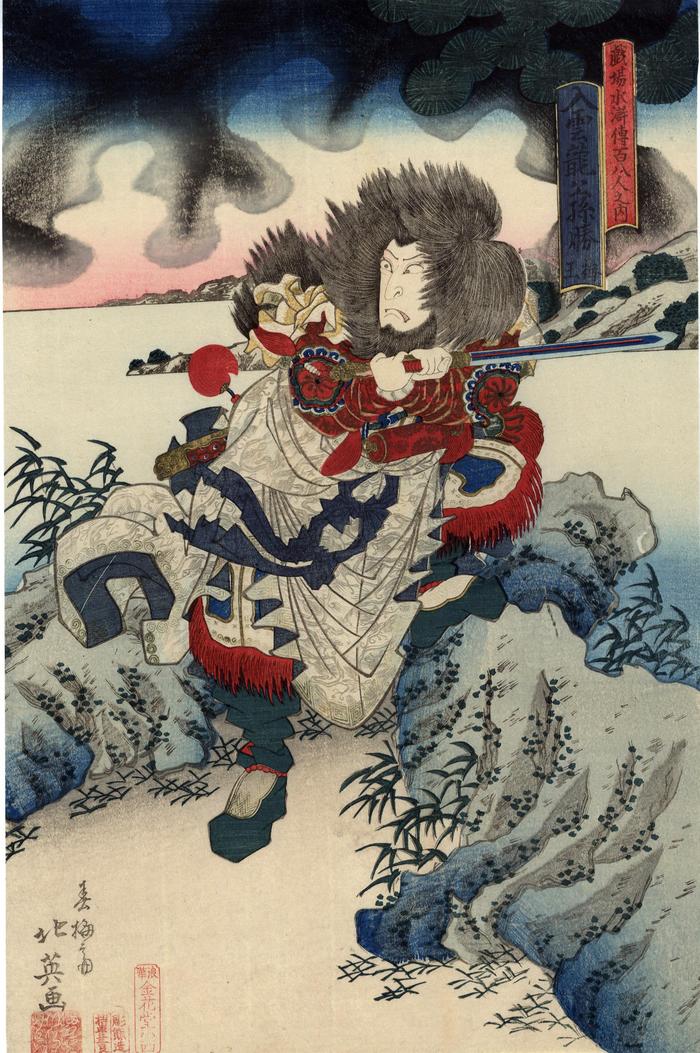Shunbaisai Hokuei (春梅斎北英) (artist )
Nakamura Utaemon III (中村歌右衛門) as Ju-unryū Kōsonshō (入雲龍公孫勝) from 108 Heroes of the Theater Suikoden (Shibai Suikoden Hykuhachinin no uchi - 戯場水滸伝百八人之内)
1835
9.8 in x 14.75 in (Overall dimensions) Signed: Shunbaisai Hokuei ga
春梅斎北英画
Artist's seal: Koshiji no ume and Fumoto no ume (trimmed at bottom
Publisher: Kinkadō Konishi (Marks 242 - seal 24-088)
Lyon (complete tetraptych)
Metropolitan Museum of Art - the full tetraptych
Hankyu Culture Foundation
Adachi Museum of Art - all four panels This is the second panel from a tetraptych.
An acclaimed masterpiece of Osaka printmaking, its detailed landscape setting provides a grand panoramic of the kabuki play, Shibau suikoden Hyakuhachinin no uchi (108 Heroes of the Theatre Suikoden), performed in the 11th month of 1835 in Osaka. In this pristine example is Nakamura Utaemon III (1778-1838) as Ju-unryū Kōsonshō.
Tales of the Chinese legendary “Suikoden” (water margin) outlaws and their adventures were easily adapted to exciting dramas for the kabuki stage. In this color woodcut Hokuei captured a particular performance, but other print artists (such as Kuniyoshi in this exhibition) simply illustrated the well-known stories from their own imaginations.
****
Illustrated in:
1) Ikeda Bunko, Kamigata yakusha-e shūsei (Collected Kamigata Actor Prints), vol. 2, Osaka, 1998, No. 341.
2) The full composition in color in Masterpieces of Japanese Prints: The European Collections - Ukiyo-e from the Victoria and Albert Museum II, Kodansha International, 1991, pp. 130-31.
color in 3) in 原色浮世絵大百科事典 (Genshoku Ukiyoe Daihyakka Jiten), vol. 9, pp. 124-125.
4) In a two page color fold-out in The Theatrical World of Osaka Prints by Roger Keyes and Keiko Mizushima, Philadelphia Museum of Art, text on page 146, 1973.
5) color in Ukiyo-e to Shin hanga: The Art of Japanese Woodblock Prints, Mallard Press, 1990, p. 182.
6) color in Ukiyo-e Masterpieces in European Collection 5: Victoria and Albert Museum II, Kodansha, 1989, #153.
7) a large color reproduction over two page in Japanese Prints by Catherine David, 2010, Éditions Place des Victoires, p. 294-95. [The full four panels.]
8) a full-page color reproduction in Ukiyo-e to Horimono: the history and art of Japanese Prints and Tattooing by Jan van Doesburg, 2013, fig. 028, pp. 120-121. The full tetraptych.
9) in color, the whole tetraptych, in Hokuei: Master of Osaka Kabuki Prints by John Fiorillo, Ludion, 2024, cat. 224, pages 124-125. And in a small color reproduction on page 197.
****
The Sword, the Dragon and Water
Willem van Gulik in his book Irezumi wrote extensively about this subject.
"This phenomenon of protection afforded by (seemingly) opposing elements, has meanwhile become a recurrent and familiar theme. The relation of the elements water and metal, both opposed to fire, as expressed in the trinity dragon tattoo... [This] contrast-harmony of metal and water as symbolized by sword and dragon is perhaps most distinctively expressed by the so-called kurikara-ryō symbol, represented by a dragon coiled around a swordblade. The combination is said to be connected with the legend of the stormgod Susa-no-o killing the dragon in whose tail he finds the heavenly sword which he presents to his sister, the Sun-goddess Amaterasu. An allusion to this legendary episode may well be represented in fig. 106, depicting the hero Ju-unryū Kōsonshō, from the famous Suikoden print series by Kuniyoshi. The kurikara-ryō is also said to be generally accepted as the symbolization of the union of the yin and yang principles. As such, it may serve as a protective and auspicious emblem, often met with as an ornamental design... The water (dragon) and metal (sword) are attracted to each other, may easily be explained in terms of their relation in the cycle of the five elements. In this cycle... metal and water stand in a position diametrically opposed to fire. Furthermore, they are closely related in that metal generates water in the mutual production order of the five elements. It is therefore quite natural that the metal-water combination may be so distinctly encountered in the kurikara-ryō representation."
The choice of bold type is our own. (JSV)
Nakamura Utaemon III (三代目中村歌右衛門) (actor)
actor prints (yakusha-e - 役者絵) (genre)
Kyōto-Osaka prints (kamigata-e - 上方絵) (genre)
Kinkadō Konishi (金花堂小西) (publisher)
Suikoden (水滸傳) (genre)
